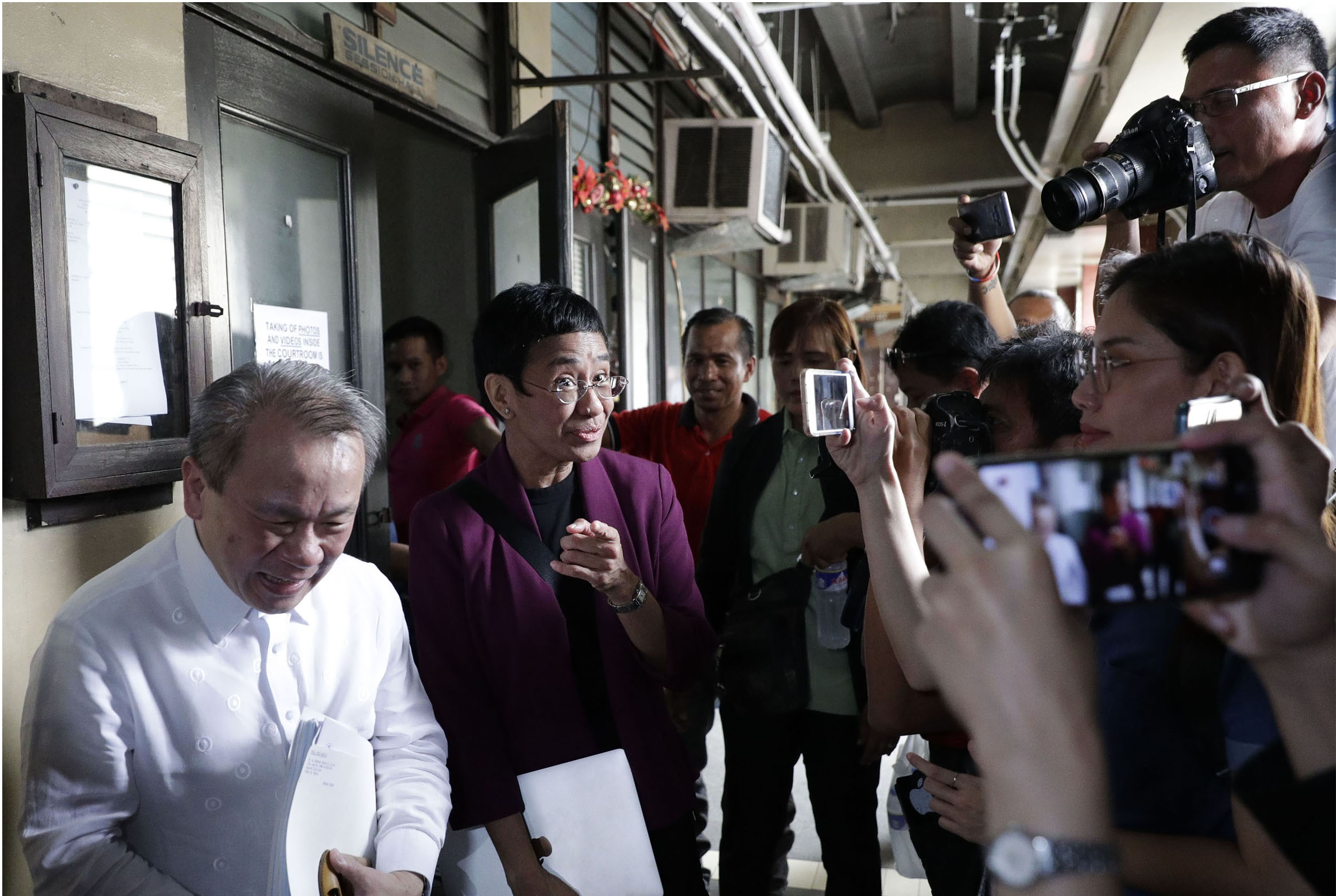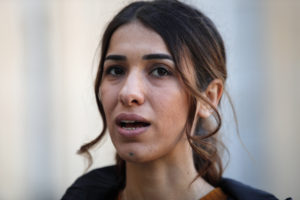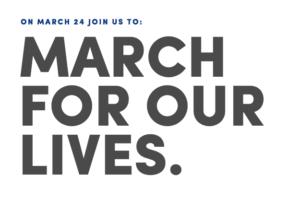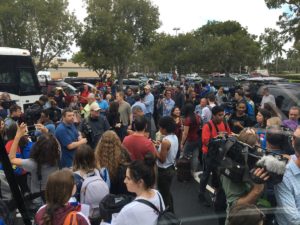Female Journalists Still Bear the Brunt of Cyberattacks
Even in countries that value press freedom, women are routinely subjected to threats of rape and other forms of online abuse. Rappler CEO and Executive Editor Maria Ressa, second from left, talks to reporters in the Philippines. (Aaron Favila / AP)
Rappler CEO and Executive Editor Maria Ressa, second from left, talks to reporters in the Philippines. (Aaron Favila / AP)
About 10 years ago, I was forced to contend with a cyberstalker. He had written an online novel and posted excerpts on his blog that included threats to rape me and burn my house down. He hoped to kill not only me but my two young children. I still remember the shock I felt as I read his words. My fingers felt as if they had swollen to the size of sausages; I could hardly dial for help.
But I was one of the lucky ones. My cyberstalker was arrested, questioned and finally convicted. Not only did he do jail time, he was put under a restraining order forbidding him from contacting me or visiting my address.
Other women in the public sphere who have experienced cyberstalking have not been so fortunate.
Maria Ressa, co-founder of Rappler, an online news agency in the Philippines, has lost count of the number of death and rape threats she has received since 2016, when her organization published an exposé revealing how supporters of Philippine President Rodrigo Duterte spread social media propaganda to drown out opposition. After Duterte denounced Rappler, the social media campaign machine that had helped him get elected set Ressa in its sights. She has been arrested several times since, and been the subject of such hashtag campaigns as #BringhertotheSenate and #ArrestMariaRessa. She and other reporters have been called leeches, accused of treason and labeled an enemy of the people, and female journalists have been threatened with rape and death. At one point, Ressa was threatened 90 times in one hour.
Undaunted, she has continued her reporting. She has engaged extra security for her team, as well as counseling, and she is now represented by Amal Clooney and Caoilfhionn Gallagher, barristers at Doughty Street Chambers, a London law firm and Britain’s media freedom envoy.
“Maria Ressa is a courageous journalist who is being persecuted for reporting the news and standing up to human rights abuses. We will pursue all available legal remedies to vindicate her rights and defend press freedom and the rule of law in the Philippines,” Clooney said in a press statement.
Ressa’s case isn’t unusual. The need to engage online and use social media to amplify work means that reporters can be tracked and targeted relatively easily, at least online.
A 2015 report on the security of journalists, conducted by the International News Safety Institute, revealed a leap in news organizations and individual journalists being targeted over the last 10 years. Women face grossly sexualized threats online, including rape, graphic sexual imagery and other forms of violence. Evidence suggests that women of color, women of faith (Muslims and Jews in particular) and disabled women are even more likely to be attacked.
The Organisation for Security and Co-operation in Europe (OSCE) recently published a report on the effect of such threats on media freedom. It also explored how to counter them, which isn’t easy. The anonymity of internet users and the advent of trolling is one of the most insidious forms of the suppression of free speech online. But women with public voices need to stay online, both to maintain job security and because of the nature of their work. As social media has evolved and some platforms have become peer-to-peer broadcasters, consumers have found it easier to publish themselves and to access public figures such as journalists.
Becky Gardiner, who edited the OSCE report, as well as a report on online misogyny for The Guardian, says there is no single solution to the problem. “Lawyers will get fixated on the law, others argue that the law is good enough but it is difficult to prosecute, others [say] that we need to train the judiciary better. I think it’s also a cultural problem.”
Gardiner, who lectures on journalism at Goldsmiths, the University of London college, notes that her Guardian study demonstrated that minority ethnic journalists are targeted in particular: “Nonwhite people, Muslims and Jews get abused as well, and if you are a combination, that’s worse; probably the worst is to be a female Muslim. People who write about the experience of being refugees are also likely to get abuse online. The research I did for The Guardian was only designed to look at the abuse women got, but what rose to the top of the pile of ‘most abused’ was that all were nonwhite.”
The OSCE report backs up a 2013 survey conducted by the International Women’s Media Foundation (IWMF), which documented attacks against female journalists. The report, titled “Violence and Harassment Against Women in the News Media,” provided a chilling international picture of the threats and risks faced by female reporters and laid out how the current landscape affects work capability. More recent research by the IWMF, in partnership with the organization TrollBusters, found that nearly two-thirds of female journalists polled had experienced online harassment.
In the 2013 survey, almost two‑thirds of the 149 female journalists polled experienced intimidation, threats or abuse related to their work. A quarter of the threats, including those to family and friends, took place in the digital sphere. The threats differed from those leveled at men, the majority of which focused on political and other differences of opinion.
Over a quarter of the women said the threats came from government, 15% from the police and 12% from lobbyists, story subjects and others. Forty-five percent were unable to identify the source of the threats.
But whomever the source, the object of such harassment is to silence women with public voices.
British Paralympian and parliamentarian Tanni Grey-Thompson, a wheelchair user, feels she is doubly targeted. She recently experienced what she calls a “sizeable pile-on by men” when she pushed back against being referred to in a professional meeting as a “girl.” She says male commenters accused her of lying, of making a fuss and being an “idiot.” It wasn’t an isolated occurrence. “I’ve received nasty comments based on me being a wheelchair user, but also because I’m female,” she says. “I think women … face enormous abuse on social media platforms, far more than many men face for saying the same thing. I think it is especially pertinent if women are discussing feminist issues. We are told to shut up, go back to the kitchen and wear dresses.
“This is at the lesser end; it becomes far worse,” she continues. Although she hasn’t experienced being threatened with rape, she notes that it can take a long time for internet providers to remove such threats. “Pictures sexualizing children seem to be in the same category,” she says. “A woman can ask a simple question or comment [and] they are reported and removed. It feels quite misogynistic.”
In the most recent OSCE report, the Dart Centre, which promotes ethical reporting on conflicts and tragedy, noted that differentiating between various forms of harassment may help explain the phenomenon. As the IWMF research showed, online abusers of journalists can have different motives. Some seek to prevent a journalist from pursuing a specific story, humiliate her for past reporting, or prevent her or a news organization from covering an entire beat. According to the Dart Centre, while online intimidation of female journalists may seem gender-based, the motives are “typically strategic self‑interest and/or political.” This aligns with what Ressa experienced—she suspects that the online abuse of her and her staff is being carried out by pro-Duterte factions in order to smear her name and champion his agenda. But in 2016, when Ressa asked Duterte whether he was aware of the vicious army of trolls who promote him, “He just said, ‘You know that I’m not online.’”
The abuse of female journalists is an international problem. During the 2019 lab on Online Harassment of Women Journalists, convened in Ethiopia by international partners including UNESCO and the World Wide Web Foundation, African women in media organizations detailed how they were targeted by online misogyny when they reported on a range of political issues, especially those dealing with women’s rights and gender-based violence. This is also true in countries where press freedom is prized.
Although the number of threats male and female journalists receive are similar, they are very different in nature. The Finnish Union of Journalists, which surveyed journalists in 2016, found that 14% of women polled reported being threatened with sexual violence. None of the male journalists polled reported such threats, although 5% of both men and women polled said that they had received death threats.
Organizations like IWMF are working to protect female journalists. IWMF has provided seed money for the nongovernmental organization TrollBusters, established by Michelle Ferrier in 2015, years after her own case of racist harassment, when she realized that there had been little change in the social media culture. She had been a respected African American columnist for the Daytona Beach News-Journal in Florida. The hate mail started coming in 2005, two years after she began writing. “Before this world ends, there will be a race war,” one letter said. Another asked, “Have you played the race card Michelle this week?” Others were so insulting and threatening that Ferrier began to fear. She learned to how shoot a gun and sought police protection. Finally, she left her job and became a journalism professor.
TrollBusters works with digital partners to assemble evidence about how female journalists are threatened and harassed online, and suggests ways to counter it.
Ferrier says her organization is a “just-in-time rescue service for women journalists. We provide a hedge of protection around women so they can persist online and tell the story, and not become the story.”
According to Gardiner, who edited the OCSE report and was a former comment editor at The Guardian, “The approach of building networks is good. On The Guardian, before publishing certain pieces, we used to tip off two or three people beforehand and agree on a launch time. If you get in early [to the online comments] and set a positive narrative, then that is dominant and the writer doesn’t care so much if people also say horrible things in the thread.”
Business writer Heidi N. Moore affirms that when women tweet about politics and other fraught issues, unwelcome attention can result. “Political bot networks target women who tweet about politics in order to silence them,” she notes in a thread on Twitter. It is “a renewed and concerted effort to keep women out of digital political spaces.” She adds that online violence “is as real as a punch.”
Moore is right: Online trauma manifests itself in the body. I know that firsthand. I began researching misogynistic cyberstalking in 2014 and came across case after case in which a woman’s health had suffered in the aftermath of online hate, with studies showing that many of us exhibited signs of post-traumatic stress disorder.
Gardiner believes that media organizations can better manage the online world. “The web opened up this idea that everyone should have their say … [but] media organizations were unprepared for the explosion of people wanting to do it. Media companies did it for commercial reasons and wanted to show engagement and clicks, but didn’t do anything to listen to the responses. That made people angry. Those people who already felt that women have too much power directed that anger at women. And when their comment was ignored or deleted, that reinforced their misogyny.”
Danielle Citron, a Boston University law professor and author of “Hate Crimes in Cyberspace,” said in an email interview that she is ambivalent about the progress made since her book was published. “On the one hand, the threat seems to be growing,” she says. “Since the 2016 election, we have seen bigoted harassment rise, in part because even U.S. leaders have encouraged and normalized bigoted attacks on individuals and groups and because the smaller groups I watched (men’s rights folks on 4chan/8chan) have seemingly grown in number. On the other [hand], there is greater awareness … from dominant platforms that far more needs to be done.”
Citron notes that In 2014, only two or three states in the U.S. had laws against invasions of sexual privacy. Now, she says, 43 states and the District of Columbia criminalize nonconsensual porn and other invasions of sexual privacy. She also calls attention to the SHIELD Act proposed by California Rep. Jackie Speier, which seeks to address so-called “revenge porn.”
For months after my experience with cyberstalking, I was too shaken to venture online. My case had been picked up by the media, and I felt revictimized rather than supported by the coverage. Eleven years later, I’ve pretty much moved on. But in the back of my mind, every time I tweet, I am aware that, as a woman online, I have to be wary of being too controversial, lest I face more rape and death threats.
Yet for journalists, who are committed to freedom of expression, advocating for tough regulation on cyberabuse that could be seen as censorship is a tough thing to do. In the United Kingdom, the Law Commission, a quasi-autonomous nongovernmental organization that advises government on law reform, is weighing whether more needs to be done to protect women and minority groups from online abuse. Freedom of speech organizations are rightly wary about introducing laws that could be misused by vexatious litigants, creating a chilling environment.
Still, when half of the world’s population feels that it cannot take part freely in online spaces without being intimidated or even silenced, fresh thinking is needed to design programs that increase and protect women’s participation online.
Your support matters…Independent journalism is under threat and overshadowed by heavily funded mainstream media.
You can help level the playing field. Become a member.
Your tax-deductible contribution keeps us digging beneath the headlines to give you thought-provoking, investigative reporting and analysis that unearths what's really happening- without compromise.
Give today to support our courageous, independent journalists.






You need to be a supporter to comment.
There are currently no responses to this article.
Be the first to respond.